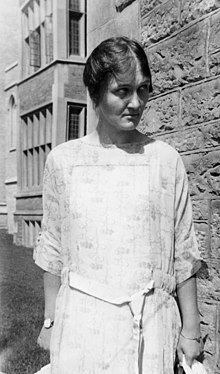Cecilia Payne-Gaposchkin
| Cecilia Payne-Gaposchkin | |
|---|---|
 |
|
| Born |
May 10, 1900 Wendover, Buckinghamshire |
| Died | December 7, 1979 (aged 79) Cambridge, Massachusetts |
| Residence | Lexington, Massachusetts |
| Citizenship | British-American |
| Nationality | British (English) |
| Fields | Astronomy, Astrophysics |
| Institutions | Harvard College Observatory, Harvard University |
| Education | St Paul's Girls' School |
| Alma mater | Newnham College, Cambridge, Radcliffe College (Harvard College Observatory) |
| Doctoral advisor | Harlow Shapley, Arthur Eddington |
| Doctoral students | Helen Sawyer Hogg, Joseph Ashbrook, Frank Kameny, Frank Drake, Paul W. Hodge |
| Known for | Explanation of spectra of Sun, more than 3,000,000 observations of variable stars |
| Notable awards | Annie J. Cannon Award in Astronomy (1934), Rittenhouse Medal (1961), Award of Merit from Radcliffe College (1952), Henry Norris Russell Prize (1976) |
| Signature | |
Cecilia Helena Payne-Gaposchkin (May 10, 1900 – December 7, 1979) was a British–American astronomer and astrophysicist who, in 1925, proposed in her Ph.D. thesis an explanation for the composition of stars in terms of the relative abundances of hydrogen and helium.
Cecilia Helena Payne was one of three children born in Wendover, England, to Emma Leonora Helena (née Pertz) and Edward John Payne, a London barrister, historian and accomplished musician. Her mother came from a Prussian family and had two distinguished uncles, historian Georg Heinrich Pertz and the Swedenborgian writer James John Garth Wilkinson. Cecilia Payne's father died when she was four years old, forcing her mother to raise the family on her own.
She attended St Paul's Girls' School. In 1919, she won a scholarship to Newnham College, Cambridge University, where she read botany, physics, and chemistry. Here, she attended a lecture by Arthur Eddington on his 1919 expedition to the island of Principe in the Gulf of Guinea off the west coast of Africa to observe and photograph the stars near a solar eclipse as a test of Einstein's general theory of relativity. This sparked her interest in astronomy. She completed her studies, but was not awarded a degree because of her sex; Cambridge did not grant degrees to women until 1948.
...
Wikipedia
